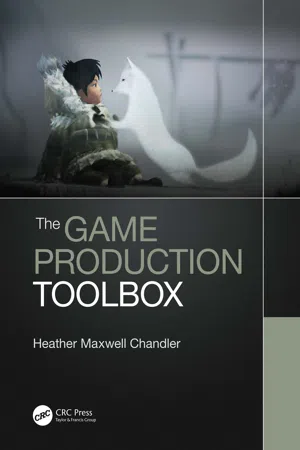
- 296 pages
- English
- ePUB (mobile friendly)
- Available on iOS & Android
The Game Production Toolbox
About this book
The Game Production Toolbox focuses on the nuts and bolts of producing interactive content and how you can organize and support the creative, technical, and business efforts that are all part of interactive game development. This book isn't going to tell you how to design a game or what technologies to use. Instead it provides techniques for and insights into managing, from concept to release, all the pieces that must come together in order to get a game into the hands of a player.
Readers will learn about each phase of game production: prototyping, defining the requirements, assembling the team, making the game, and releasing to the players. Interviews from professional game developers give a behind-the-scenes look at what it takes to make a game.
Key Features
- A framework for how to get an interactive game from concept to release, including information on financing and pitching to publishers and investors.
- Techniques for working with the game development team to get effective prototypes and documentation to prove out game concept and mechanics.
- Concrete information on how to plan and execute the different aspects of game production, such as audio, localization, testing, and software ratings.
- Advice from industry experts on managing teams, project management, communicating effectively, and keeping everyone happy.
- Information about working effectively with marketing, PR, and other people that are involved with the publishing and release process.
Frequently asked questions
- Essential is ideal for learners and professionals who enjoy exploring a wide range of subjects. Access the Essential Library with 800,000+ trusted titles and best-sellers across business, personal growth, and the humanities. Includes unlimited reading time and Standard Read Aloud voice.
- Complete: Perfect for advanced learners and researchers needing full, unrestricted access. Unlock 1.4M+ books across hundreds of subjects, including academic and specialized titles. The Complete Plan also includes advanced features like Premium Read Aloud and Research Assistant.
Please note we cannot support devices running on iOS 13 and Android 7 or earlier. Learn more about using the app.
Information
PART 1
Overview
CHAPTER 1
Game Industry Overview
1.1 Introduction
1.2 Game Development Framework
- Create the Prototype: This initial phase is where you decide what game you are making, who you are making it for, and what the key gameplay mechanics are. The work done in this phase has a direct impact on the success of your game. You have more freedom to explore new things and make mistakes because nothing is set in stone. You can make a lot of decisions that will impact the quality of the game. The focus is on “finding the fun” through prototyping and feedback. Part 2 of this book delves more deeply into how you can make the most of creating your pitch.
- Establish Requirements: Once you have an understanding of what you want to make, you need to plan how you are going to make it. How much time and money is necessary? What people are needed for the development team? Answering these questions now puts your game in a better position to succeed. Part 3 provides more specifics on how to create a budget, schedule, and overall production plan.
- Assemble the Team: As you define what game you’re making, you will need people who can help. How do you find these people? How do you organize the team? How do you keep the team happy and motivated? Part 4 answers these questions and more.
- Make the Game: You have the money, the people, and the time, and now the team is ready to create the game. In a perfect world, this phase is simply executing your plan—all the questions are answered, all risks are mitigated, and you have everything you need to make the game from start to finish. The reality is that this phase will have its bumps and obstacles as well. The producer will be putting out fires, reworking plans, and keeping the chaos contained. Part 5 discusses how to navigate the ins and outs of making the game. This includes coordinating all the moving parts and determining when the game is done, and offers strategies for getting a project back on track.
- Launch the Game: Finally, the game is ready for the players. Testing finishes up, third parties have signed off, marketing campaigns are in flight, and the players wait in eager anticipation. During the launch phase, the focus is on getting all the pieces in place for customer service, community management, and the live operations of the game. After the game is launched, expect to deal with player feedback, bugs, rolling out new features, and anything else that is needed to maintain the health of the game.
1.3 Financing Options
1.3.1 Self-Financing
Table of contents
- Cover
- Half Title
- Title Page
- Copyright Page
- Dedication
- Table of Contents
- Foreword
- Preface
- Acknowledgments
- Author
- Part 1 Overview
- Part 2 Creating the Prototype
- Part 3 Establishing Requirements
- Part 4 Assembling the Game Team
- Part 5 Making the Game
- Part 6 Launching the Game
- Part 7 Appendices
- Appendix A: Acronyms
- Appendix B: Resources and Tools
- Appendix C: Biographies of Interviewees
- References
- Index